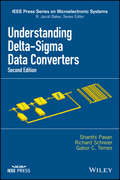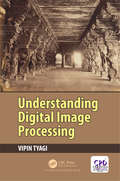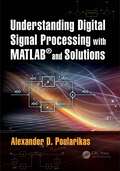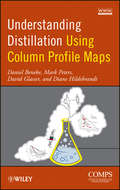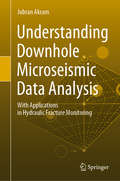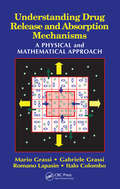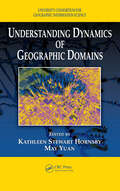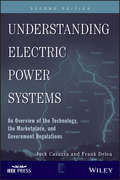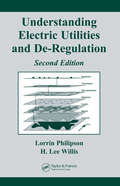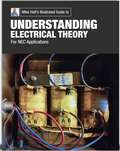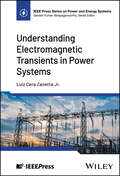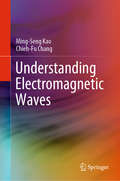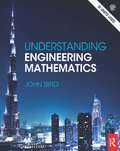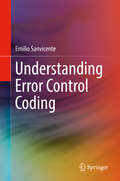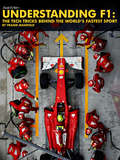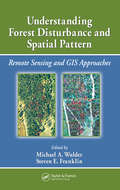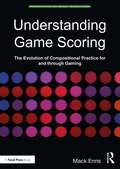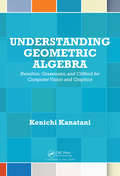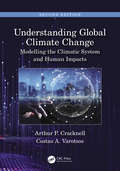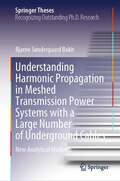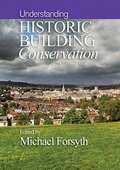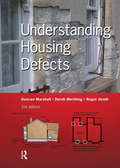- Table View
- List View
Understanding Delta-Sigma Data Converters (Second Edition)
by Gabor C. Temes Richard Schreier Shanthi PavanThis new edition introduces operation and design techniques for Sigma-Delta converters in physical and conceptual terms, and includes chapters which explore developments in the field over the last decade Includes information on MASH architectures, digital-to-analog converter (DAC) mismatch and mismatch shaping Investigates new topics including continuous-time ΔΣ analog-to-digital converters (ADCs) principles and designs, circuit design for both continuous-time and discrete-time ΔΣ ADCs, decimation and interpolation filters, and incremental ADCs Provides emphasis on practical design issues for industry professionals
Understanding Digital Image Processing
by Vipin TyagiThis book introduces the fundamental concepts of modern digital image processing. It aims to help the students, scientists, and practitioners to understand the concepts through clear explanations, illustrations and examples. The discussion of the general concepts is supplemented with examples from applications and ready-to-use implementations of concepts in MATLAB®. Program code of some important concepts in programming language 'C' is provided. To explain the concepts, MATLAB® functions are used throughout the book. MATLAB® Version 9.3 (R2017b), Image Acquisition Toolbox Version 5.3 (R2017b), Image Processing Toolbox, Version 10.1 (R2017b) have been used to create the book material. Meant for students and practicing engineers, this book provides a clear, comprehensive and up-to-date introduction to Digital Image Processing in a pragmatic manner.
Understanding Digital Signal Processing with MATLAB and Solutions (The Electrical Engineering and Applied Signal Processing Series)
by Alexander D. PoularikasThe book discusses receiving signals that most electrical engineers detect and study. The vast majority of signals could never be detected due to random additive signals, known as noise, that distorts them or completely overshadows them. Such examples include an audio signal of the pilot communicating with the ground over the engine noise or a bioengineer listening for a fetus’ heartbeat over the mother’s. The text presents the methods for extracting the desired signals from the noise. Each new development includes examples and exercises that use MATLAB to provide the answer in graphic forms for the reader's comprehension and understanding.
Understanding Distillation Using Column Profile Maps
by David Glasser Diane Hildebrandt Mark Peters Daniel BenekeResearchers share their pioneering graphical method for designing almost any distillation structure Developed by the authors in collaboration with other researchers at the Centre of Material and Process Synthesis, column profile maps (CPMs) enable chemical engineers to design almost any distillation structure using novel graphical techniques. The CPM method offers tremendous advantages over other design methods because it is generalized and not constrained to a particular piece of equipment. Understanding Distillation Using Column Profile Maps enables readers to understand, analyze, and design distillation structures to solve common distillation problems, including distillation by simple columns, side rectifiers and strippers, multiple feed columns, and fully thermally coupled columns. In addition, the book presents advanced topics such as reactive distillation, membrane permeation, and validation of thermodynamic models. For all these processes, the authors set forth easy-to-follow design techniques, solution strategies, and insights gained using CPMs. This book offers everything needed to fully understand and use CPMs as a design tool: Figures help readers understand how to use CPMs as design and optimization tools Examples clearly illustrate how to solve specific problems using CPMs Tutorials allow readers to explore key concepts through experimentation Design and Optimization of Distillation Systems software package, developed for this book, enables readers to reproduce the examples in the book, follow the tutorials, and begin designing their own distillation systems With its many examples and step-by-step tutorials, Understanding Distillation Using Column Profile Maps is recommended for students in chemical engineering in advanced undergraduate and graduate courses. The book also provides new practical techniques that can be immediately applied by chemical engineering professionals in industry.
Understanding Downhole Microseismic Data Analysis: With Applications in Hydraulic Fracture Monitoring
by Jubran AkramThis book is designed as an excellent resource text for students and professionals, providing an in-depth overview of the theory and applications of downhole microseismic monitoring of hydraulic fracturing. The readers will benefit greatly from the detailed explanation on the processes and workflows involved in the acquisition design modeling, processing and interpretation of microseismic data.
Understanding Drug Release and Absorption Mechanisms: A Physical and Mathematical Approach
by Mario Grassi Gabriele Grassi Romano Lapasin Italo ColomboDemand for better reliability from drug delivery systems has caused designers and researchers to move away from trial-and-error approaches and toward model-based methods of product development. Developing such models requires cross-disciplinary physical, mathematical, and physiological knowledge. Combining these areas under a single cover, Under
Understanding Dynamics of Geographic Domains
by Kathleen Stewart Hornsby May YuanAlthough the dynamic aspect of the world is widely recognized, information systems have lagged in their ability to represent these dynamics and provide support for users and analysts, especially those who work with dynamic geographic domains. A collection of peer-reviewed articles, Understanding Dynamics of Geographic Domains showcases new research
Understanding Electric Power Systems: An Overview of the Technology, the Marketplace, and Government Regulations (IEEE Press Understanding Science & Technology Series #23)
by Jack Casazza Frank DeleaA COMPREHENSIVE LOOK IN LAYMAN'S TERMS AT THE MANY ASPECTS OF THE PROVISION OF ELECTRIC POWER, BY TWO VETERAN EXECUTIVES AND RESPECTED EXPERTS Technological advances and changes in government policy and regulation have altered the electric power industry in recent years and will continue to impact it for quite some time. Fully updated with the latest changes to regulation, structure, and technology, this new edition of Understanding Electric Power Systems offers a real-world view of the industry, explaining how it operates, how it is structured, and how electricity is regulated and priced. It includes extensive references for the reader and will be especially useful to lawyers, government officials, regulators, engineers, and students, as well as the general public. The book explains the physical functioning of electric power systems, the electric power business in today's environment, and the related institutions, including recent changes in the roles of the Federal Energy Regulatory Commission and the North American Reliability Company. Significant changes that are affecting the industry are covered in this new edition, including: The expanded role of the federal government in the planning and operation of the nation's electric utilities New energy laws and a large number of FERC regulations implementing these laws Concerns over global warming and potential impacts on the electric industry Pressures for expansion of the electric grid and the implementation of "smart-grid" technologies The growing importance of various energy-storage technologies and renewable energy sources New nuclear generation technologies The 2009 economic stimulus package
Understanding Electric Utilities and De-Regulation
by H. Lee Willis Lorrin PhilipsonPower interruptions of the scale of the North American Blackout of 2003 are rare, but they still loom as a possibility. Will the aging infrastructure fail because deregulated monopolies have no financial incentives to upgrade? Is centralized planning becoming subordinate to market forces? Understanding Electric Utilities and De-Regulation, Second Edition provides an updated, non-technical description that sheds light on the nature of the industry and the issues involved in its transition away from a regulated environment.The book begins by broadly surveying the industry, from a regulated utility structure to the major concepts of de-regulation to the history of electricity, the technical aspects, and the business of power. Then, the authors delve into the technologies and functions on which the industry operates; the many ways that power is used; and the various means of power generation, including central generating stations, renewable energy, and single-household size generators. The authors then devote considerable attention to the details of regulation and de-regulation. To conclude, one new chapter examines aging infrastructures and reliability of service, while another explores the causes of blackouts and how they can be prevented.Based on the authors' extensive experience, Understanding Electric Utilities and De-Regulation, Second Edition offers an up-to-date perspective on the major issues impacting the daily operations as well as the long-term future of the electric utilities industry.
Understanding Electrical Theory for NEC Applications
by Charles Michael HoltDo you know where electricity comes from? This book will teach you what you need to know about how electricity behaves and the physics behind it. It is critical that all electrical professionals understand the science behind electricity in order to apply the National Electrical Code rules successfully and to work safely in the field. This book is required reading for all electrical installers from an electrical apprentice all the way up through a veteran professional. Only when you know the theory can you truly have confidence in the practical aspects of your electrical work. This full-color textbook provides hundreds of illustrated graphics, detailed examples, practice questions, practice exams, summaries and a comprehensive practice final exam. This full-color textbook provides hundreds of illustrated graphics, detailed examples, practice questions, practice exams, summaries and a comprehensive practice final exam. Chapter 1. Electrical Fundamentals Chapter 2: Uses and Dangers of Electricity Chapter 3: Magnetism and Electromagnetism Chapter 4: Mathematics Chapter 5: Ohm’s Law and Watts Law Chapter 6: Electrical Circuit Types Chapter 7: Alternating Current Chapter 8: Motors, Generators, Relays, and Transformers Chapter 9: Protective Devices Chapter 10: General Knowledge
Understanding Electromagnetic Transients in Power Systems (IEEE Press Series on Power and Energy Systems)
by Luiz Cera Zanetta Jr.Understand transients and their roles in linear systems with this essential guide Electromagnetic transients are a fundamental aspect of linear power systems, and therefore a key knowledge area for electrical engineers. Understanding Electromagnetic Transients in Power Systems provides a comprehensive but accessible overview to transients, their underlying theory and mathematics, and their impact in electrical power system design. Its detailed but clear presentation makes it a must-own for students and working engineers alike. Readers of Understanding Electromagnetic Transients in Power Systems will also find: Deep consideration of the relationship between foundational concepts, mathematical calculations, and impacts on equipmentDetailed discussion of topics including time and frequency domain analysis, basic transforms, fundamentals of electrical circuit transients and traveling waves, overvoltage, insulation coordination, and many moreDozens of solved simple examples to facilitate understanding Understanding Electromagnetic Transients in Power Systems is ideal for electrical engineers and professionals in utilities and equipment manufacturing, as well as for graduate and advanced undergraduate students learning about transients, electrical circuits, and related subjects.
Understanding Electromagnetic Waves
by Ming-Seng Kao Chieh-Fu ChangThis one-semester textbook teaches students Electromagnetic Waves, via an early introduction to Maxwell’s Equations in the first chapter. Mathematics fundamentals are used as needed, but rigor is de-emphasized in preference to understanding the basic ideas and principles of EM waves. Each chapter includes extensive, step-by-step, solved examples, as well as abundant exercises. Designed for a one-semester course in electromagnetic waves;Introduces Maxwell’s equations in the first chapter;De-emphasizes mathematical rigor in order to make key ideas and principles easy to understand;Makes material accessible to readers of varying backgrounds, with extensive use of solved examples;Includes abundant exercises for each chapter.
Understanding Engineering Mathematics
by John BirdStudying engineering, whether it is mechanical, electrical or civil relies heavily on an understanding of mathematics. This new textbook clearly demonstrates the relevance of mathematical principles and shows how to apply them to solve real-life engineering problems. It deliberately starts at an elementary level so that students who are starting from a low knowledge base will be able to quickly get up to the level required. Students who have not studied mathematics for some time will find this an excellent refresher. Each chapter starts with the basics before gently increasing in complexity. A full outline of essential definitions, formulae, laws and procedures are introduced before real world situations, practicals and problem solving demonstrate how the theory is applied. Focusing on learning through practice, it contains examples, supported by 1,600 worked problems and 3,000 further problems contained within exercises throughout the text. In addition, 34 revision tests are included at regular intervals. An interactive companion website is also provided containing 2,750 further problems with worked solutions and instructor materials
Understanding Error Control Coding
by Emilio SanvicenteThis book is addressed to newcomers to error control coding (ECC), making the subject easy to understand and to apply in a variety of cases. The book begins by presenting in a detailed, step-by-step manner the plethora of parts an ECC system has and the way they interact to achieve the performance required. Contrary to the more abstract and formal approach followed in most books on this topic, this book is unique in that all of the concepts, methods, techniques and algorithms are introduced by way of examples. Thus, the book is almost a workbook, and therefore very suitable for self-study. Readers are encouraged to take an active role while reading, performing calculations as chapters’ progress. Moreover, to reinforce the learning process, many of the topics introduced in the book (Galois fields, Extended Hamming codes, Reed-Solomon codes, interleaving, erasure correction, etc.) are presented in various parts of the book in different ways or contexts. Offers a practical guide to error control coding, accessible to readers with varying backgrounds;Provides newcomers with a sound foundation in error control coding, using a select few topics considered by the author fundamental from an engineering point of view;Presents material with minimal mathematics;Motivates carefully concepts, methods and algorithms making clear the idea behind the conditions for the code to work.
Understanding F1: The Tech Tricks Behind The World's Fastest Sport
by Fraser MasefieldFormula 1: It's the most thrilling, intriguing and action-packed sport on the planet. It's also the most technologically advanced sport and therefore one of the most easily misunderstood. In Understanding F1, Fraser Masefield uses the 2012 races to explain the technological innovations that helped make this season such a classic.
Understanding Forest Disturbance and Spatial Pattern: Remote Sensing and GIS Approaches
by Steven E. Franklin Michael A. WulderRemote sensing and GIS are increasingly used as tools for monitoring and managing forests. Remotely sensed and GIS data are now the data sources of choice for capturing, documenting, and understanding forest disturbance and landscape pattern. Sitting astride the fields of ecology, forestry, and remote sensing/GIS, Understanding Forest Disturbanc
Understanding Forfeitures
by Noreen Clancy Amy RichardsonThe Treasury Executive Office for Asset Forfeiture (TEOAF) administers the Treasury Forfeiture Fund (TFF), which receives deposits of nontax forfeitures made by current and former Treasury agencies. Participating agencies use TFF funds to disrupt and dismantle criminal enterprises. This report examines the relationship between targeted funding support of major financial investigations and the forfeiture outcomes of such investigations.
Understanding GIS through Sustainable Development Goals: Case Studies with QGIS
by Paul HollowayUnderstanding GIS through Sustainable Development Goals applies a pedagogical shift to learning GIS, as the readers employ the concepts and methodologies on real-world problems. This book provides 16 case studies across most of the Sustainable Development Goals (SDGs) with step-by-step practical instructions using QGIS(Quantum Geographic Information System) , an open-source software. It helps readers develop GIS skills on real-world data, while learning the fundamentals including spatial data models, projections, and spatial databases, different cartographic methods, such as graduated symbology, change maps, and dynamic visualization, as well as more intermediate and advanced spatial analysis such as geoprocessing, multiple criteria analysis, and spatial statistics. The topics chosen are taught in secondary and tertiary education institutions which make this a textbook for all students and educators. Features: Focuses on learning GIS through 16 real world case studies. Introduces an open-source software that can be used beyond the classroom. Analyzes Sustainable Development Goals in a global framework and provides an alternative approach to learning GIS. Supports both secondary and tertiary educators and improves GIS education at all levels. Contains a holistic range of case studies that extend across several disciplines, from geography education, environmental sciences, geosciences, natural sciences, social sciences, and digital humanities. This is a textbook for all students and educators, providing 16 case studies across most of the SDGs with step-by-step practical instructions using QGIS, an open-source software.
Understanding Game Scoring: The Evolution of Compositional Practice for and through Gaming (Perspectives on Music Production)
by Mack EnnsUnderstanding Game Scoring explores the unique collaboration between gameplay and composition that defines musical scoring for video games. Using an array of case studies reaching back into the canon of classic video games, this book illuminates the musical flexibility, user interactivity and sound programming that make game scoring so different from traditional modes of composition. Mack Enns explores the collaboration between game scorers and players to produce the final score for a game, through case studies of the Nintendo Entertainment System sound hardware configuration, and game scores, including the canonic scores for Super Mario Bros. (1985) and The Legend of Zelda (1986). This book is recommended reading for students and researchers interested in the composition and production of video game scores, as well as those interested in ludo-musicology.
Understanding Geometric Algebra: Hamilton, Grassmann, and Clifford for Computer Vision and Graphics
by Kenichi KanataniUnderstanding Geometric Algebra: Hamilton, Grassmann, and Clifford for Computer Vision and Graphics introduces geometric algebra with an emphasis on the background mathematics of Hamilton, Grassmann, and Clifford. It shows how to describe and compute geometry for 3D modeling applications in computer graphics and computer vision.Unlike similar texts
Understanding Global Climate Change: Modelling the Climatic System and Human Impacts
by Arthur P Cracknell Costas A VarotsosClimate change, a familiar term today, is far more than just global warming due to atmospheric greenhouse gases including CO2. In order to understand the nature of climate change, it is necessary to consider the whole climatic system, its complexity, and the ways in which natural and anthropogenic activities act and influence that system and the environment. Over the past 20 years since the first edition of Understanding Global Climate Change was published, not only has the availability of climate-related data and computer modelling changed, but our perceptions of it and its impact have changed as well. Using a combination of ground data, satellite data, and human impacts, this second edition discusses the state of climate research today, on a global scale, and establishes a background for future discussions on climate change. This book is an essential reference text, relevant to any and all who study climate and climate change. Features Provides a thought-provoking and original approach to the science of climate. Emphasises that there are many factors contributing to the causation of climate change. Clarifies that while anthropogenic generation of carbon dioxide is important, it is only one of several human activities contributing to climate change. Considers climate change responses needed to be undertaken by politicians and society at national and global levels. Totally revised and updated with state-of-the-art satellite data and climate models currently in operation around the globe.
Understanding Harmonic Propagation in Meshed Transmission Power Systems with a Large Number of Underground Cables: New Analytical Methods (Springer Theses)
by Bjarne Søndergaard BukhThis outstanding PhD thesis reports on new analytical methods developed to analyse harmonic propagation in large transmission systems. The focus is on understanding the physical relationships between harmonic propagation phenomena in the passive grid caused by grid expansions or changes to existing transmission lines. Principal component analysis and partial least squares regression have been used as tools to investigate statistical correlations between harmonic distortion levels at substations, and a harmonic propagation model based on standing wave phenomena and techniques known from radio and microwave theory has been developed. Knowledge of the propagation phenomena has also been used to develop a new method for determining appropriate locations for harmonic mitigating equipment in a grid. Finally, the methods have been validated through both simulation models and harmonic voltage measurements obtained from the Danish transmission grid. Overall, this thesis reports new insights into harmonic propagation in power systems as the use of underground cables increases and offers new tools for analysing such phenomena. No previous examples of data-driven analyses of measurement data from a power system in the form presented here could be found in existing literature, thus paving a way to new possibilities for this emerging field.
Understanding Historic Building Conservation (Historic Building Conservation)
by Michael ForsythThis book is the first in a series of volumes that combine conservation philosophy in the built environment with knowledge of traditional materials, and structural and constructional conservation techniques and technology: • Understanding Historic Building Conservation • Materials & Skills in Historic Building Conservation • Structures & Construction in Historic Building Conservation The series aims to introduce each aspect of conservation and to provide concise, basic and up-to-date knowledge for architects, surveyors and engineers as well as for commissioning client bodies, managers and advisors. In each book, Michael Forsyth draws together chapters by leading architects, structural engineers and related professionals to reflect the interdisciplinary nature of conservation work. The books are structured to be of direct practical application, taking the reader through the process of historic building conservation and emphasising throughout the integrative teamwork involved. This present volume – Understanding Historic Building Conservation – discusses conservation philosophy and the importance of understanding the history of a building before making strategic decisions. It details the role of each conservation team member and sets out the challenges of conservation at planning level in urban, industrial and rural contexts and in the conservation of designed landscapes. The framework of legislation and charters within which these operate is described and the book also provides guidance on writing conservation plans, explains the fundamental issues of costing and contracts for conservation and highlights the importance of maintenance. Eighteen chapters written by the experts present today’s key issues in historic building conservation: Timothy Cantell, Martin Cherry, Nigel Dann, Peter Davenport, Geoff Evans, Keith Falconer, Colin Johns, Jeremy Lake, Jonathan Lovie, Duncan McCallum, James Maitland Gard’ner, Martin Robertson, Adrian Stenning, David H. Tomback, Giles Waterfield, Philip Whitbourn, John Winter.
Understanding Housing Defects
by Derek Worthing Duncan Marshall Roger HeathThis third edition of Understanding Housing Defects provides a coherent and comprehensive introduction to the causes, investigation and diagnosis of defects in housing.Each of the eighteen chapters covers a specific building element and includes a brief introduction setting out construction principles and the evolution of current practice. Each chapter then goes on to look at the identification, cause and diagnosis of common (and sometimes not so common) defects. The text has been revised and extended with new sections on boundary walls, chimneys and basements. The Services chapter has been replaced with three new, more substantial chapters on heating and plumbing, electrical installations and drainage.
Understanding Housing Defects
by Derek Worthing Duncan Marshall Roger Heath Nigel DannUnderstanding Housing Defects provides a concise, coherent and comprehensive introduction to the causes, investigation and diagnosis of defects in domestic buildings. For this new edition, many of the chapters have been substantially updated and new photographs have been added. There are four new chapters covering: How defects are defined An overview of building and architectural history External joinery and painted finishes Environmental and health- related building problems Many of the 21 chapters cover a specific building element and include a brief introduction setting out construction principles and the evolution of current practice. All of the chapters consider the identification, cause and diagnosis of common (and sometimes not so common) defects. This book is a must have for all those students and practitioners who require a broad understanding of housing defects. Building surveyors, general practice surveyors, architects, estate agents, housing officers and anyone involved in the management and maintenance of property as well as its construction will benefit hugely from this highly informative full-colour text. Written by the authors of The Construction of Houses, the book is also the natural companion to this bestselling textbook.
